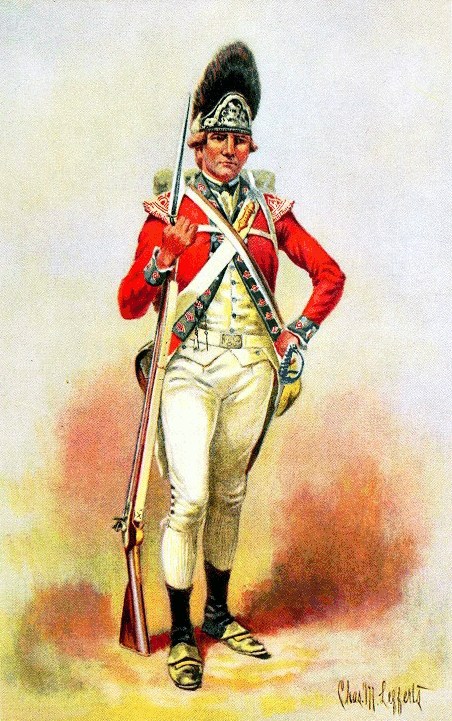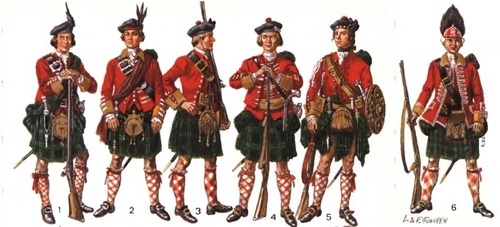|
-
12th November 14, 02:06 PM
#21
 Originally Posted by Mike_Oettle

I believe the bearskin-wearing French did not actually come into contact with the British Guardsmen, but the British Foot Guards adopted the bearskin in imitation.
IIRC, according to the documentary I posted a link to, the bearskins (of the RSDGs) were taken from the dead French soldiers.
-
-
12th November 14, 04:45 PM
#22
 Originally Posted by bwat

IIRC, according to the documentary I posted a link to, the bearskins (of the RSDGs) were taken from the dead French soldiers.
Incorrect. The RSDG had their own pattern of bearskin headdress as part of their standard uniform well before the end of the Napoleonic wars and Waterloo.
The grenadier companies of many British regiments were wearing a form of bearskin cap as a grenadier distinction as early as the mid 1700's.

Last edited by Mike S; 12th November 14 at 04:48 PM.
My Clans: Guthrie, Sinclair, Sutherland, MacRae, McCain-Maclachlan, MacGregor-Petrie, Johnstone, Hamilton, Boyd, MacDonald-Alexander, Patterson, Thompson. Welsh:Edwards, Williams, Jones. Paternal line: Brandenburg/Prussia.
Proud member: SCV/Mech Cav, MOSB. Camp Commander Ft. Heiman #1834 SCV Camp.
-
-
12th November 14, 04:51 PM
#23
Just as it was stated earlier, the legend of Waterloo revolves around the Footguards specifically taking as a battle honor the unique tall bearskin pattern used to this day based off of the French Imperial Guard grenadiers bearskin "busby".
Last edited by Mike S; 12th November 14 at 04:52 PM.
My Clans: Guthrie, Sinclair, Sutherland, MacRae, McCain-Maclachlan, MacGregor-Petrie, Johnstone, Hamilton, Boyd, MacDonald-Alexander, Patterson, Thompson. Welsh:Edwards, Williams, Jones. Paternal line: Brandenburg/Prussia.
Proud member: SCV/Mech Cav, MOSB. Camp Commander Ft. Heiman #1834 SCV Camp.
-
-
13th November 14, 01:20 AM
#24
[QUOTE=Mike S;1265701]Incorrect. The RSDG had their own pattern of bearskin headdress as part of their standard uniform well before the end of the Napoleonic wars and Waterloo.
[QUOTE]
There was another documentary in that series on the Coldstream Guards so it'll be me confusing things.
-
-
13th November 14, 04:25 AM
#25
About the origins of these things, all Barnes has to say about the development of the Feather Bonnet is
"... the Highland bonnet's feather ornamentation was gradually increasing and after that campaign (the American revolution) it flourished so much that by the end of the century there appeared to be more feathers than bonnet and it was well on its way to its ultimate full-dress form. The 42nd was granted the red hackle in 1795, and other Highland regiments all wore white with a red base (Flank Companies plain white or green)."
So, the feather bonnet can be thought of not as a separate thing but rather as an evolved form of the ordinary bonnet, what we call the Balmoral bonnet today.
Bearskin caps evolved out of the caps worn by Grenadiers, who wore special small caps because the large tricorns worn by infantry got in the way of the throwing motion. Grenadier caps had an ornamental flap in the front, which began to be trimmed with an edging of bear fur. The fur kept increasing and eventually took over the cap, and the flap kept shrinking until it disappeared altogether.
The illustration Mike posted above shows the cap in mid-evolution, mostly covered in bearskin but with the flap still present and still fairly large.
Oddly, the grenadiers of The Black Watch also wore these grenadier caps even though their small bonnets offered no impediment to throwing grenades. By this time the Grenadier company of each regiment didn't actually throw grenades any more anyhow; it had become more of a thing of honour

Here's the earlier 18th century Grenadier cap, pre-bearskin trim. You can see on their crossbelts the metal cylinder which held the match to light the grenades, which had become by this time merely ornamental

Last edited by OC Richard; 13th November 14 at 04:37 AM.
Proud Mountaineer from the Highlands of West Virginia; son of the Revolution and Civil War; first Europeans on the Guyandotte
-
-
14th November 14, 10:22 PM
#26
Sorry to wait so long before tossing in my 2 cents, but the Iroquois, an Eastern Woodlands tribe worn a hat called a Gustoweh, that was covered in feathers. Did this influence the Highlanders or was it the other way around? We may never know.��
By Choice, not by Birth
-
The Following User Says 'Aye' to Bigkahuna For This Useful Post:
-
15th November 14, 05:20 AM
#27
 Originally Posted by Bigkahuna

Sorry to wait so long before tossing in my 2 cents, but the Iroquois, an Eastern Woodlands tribe worn a hat called a Gustoweh, that was covered in feathers. Did this influence the Highlanders or was it the other way around? We may never know.��
Doubtful. The Gustoweh dates back to well before the full feather bonnet was adopted by Highland regiments. There is really no correlation with the appearance or construction that would lead one to believe that one influenced the other.
The construction is totally different, with the North Eastern headdress most often constructed with rawhide brow and crown bands, turkey, owl and other feathers attached to the top like a roach, and often a quilled brow band or trade silver crown. I've made a number of reproductions of these, as Native American material culture is a side interest of mine.
Last edited by Mike S; 15th November 14 at 05:21 AM.
My Clans: Guthrie, Sinclair, Sutherland, MacRae, McCain-Maclachlan, MacGregor-Petrie, Johnstone, Hamilton, Boyd, MacDonald-Alexander, Patterson, Thompson. Welsh:Edwards, Williams, Jones. Paternal line: Brandenburg/Prussia.
Proud member: SCV/Mech Cav, MOSB. Camp Commander Ft. Heiman #1834 SCV Camp.
-
-
15th November 14, 05:32 AM
#28
An oft-heard theory is that the feather bonnet originated when Highlanders were serving in Egypt in 1801, some tales having the Highlanders running around plucking feathers from ostriches, another account saying that the natives were doing brisk trade selling the ostrich feathers to the Highlanders.
Yet the facts don't bear this out, because as Barnes says the Feather Bonnet was already more feathers than bonnet by 1800.
We need to keep in mind that Native American dress, weapons, and tactics had an impact on the British army. As Barnes says:
"the 42nd in Canada, 1780... their dress was affected by active service, the kilt being discarded... replaced by canvas breeches... everything superfluous was eliminated until, by 1793, they were dressed and equipped almost as the Light Infantry including the Tomahawk... all white parts- waistcoat, turnbacks &c - were browned..."
Yet the fact remains that the feathers in the feather bonnet have always been ostrich, pretty much ruling out any North American connexion (the ostrich being native to Africa).
Here's Hugh Montgomery, in one of the finest portraits of Highland Dress ever painted, by John Singleton Copley, showing the beginnings of the feather bonnet. (This is the original painting, signed and dated, which hangs in Los Angeles. I'm lucky to be able to view it in person fairly often. The colours of the tartan are spectacular. BTW The National Museums Scotland has an unsigned copy by an inferior artist, and it's the latter which shows up in many books on Highland Dress. The two, the original and the copy, are easy to distinguish due to the copyist altering the position of the sword.)

Last edited by OC Richard; 15th November 14 at 05:54 AM.
Proud Mountaineer from the Highlands of West Virginia; son of the Revolution and Civil War; first Europeans on the Guyandotte
-
-
15th November 14, 06:20 AM
#29
There is a persistent echo that seems to follow me in threads of this ilk. 
Last edited by Mike S; 15th November 14 at 06:37 AM.
My Clans: Guthrie, Sinclair, Sutherland, MacRae, McCain-Maclachlan, MacGregor-Petrie, Johnstone, Hamilton, Boyd, MacDonald-Alexander, Patterson, Thompson. Welsh:Edwards, Williams, Jones. Paternal line: Brandenburg/Prussia.
Proud member: SCV/Mech Cav, MOSB. Camp Commander Ft. Heiman #1834 SCV Camp.
-
-
15th November 14, 07:58 AM
#30
While the original post may have doubted some historical timelines, the information sought has been clearly addressed and perhaps the discussion could continue without revisiting the originally suggested possibility.
-
 Posting Permissions
Posting Permissions
- You may not post new threads
- You may not post replies
- You may not post attachments
- You may not edit your posts
-
Forum Rules
|
|
Bookmarks